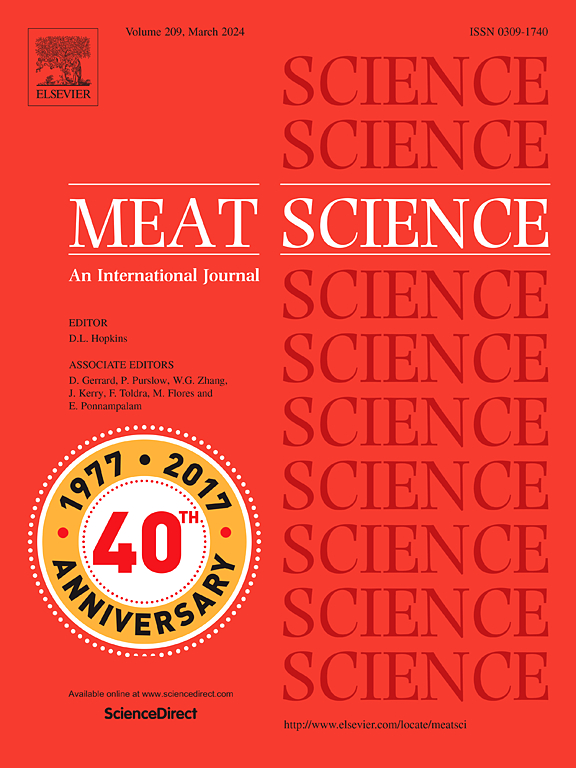淀粉/聚乙烯醇为基础的智能包装加强与回收火龙果皮衍生花青素双重功能猪肉新鲜度监测和延长保质期
IF 6.1
1区 农林科学
Q1 Agricultural and Biological Sciences
引用次数: 0
摘要
本文以淀粉-聚乙烯醇(PVA)为基质,加入花青素和ε-聚赖氨酸盐酸盐(ε-PL),设计了ph敏感型智能包装薄膜,以实现新鲜度监测和保鲜功能。所有的膜制剂一式三份,并在每个制剂的三个平行样品上进行形态结构、物理化学性质和功能生物活性的后续表征。与淀粉- pva膜相比,改性膜的性能显著提高(P < 0.05),花青素与ε-PL之间的氢键作用增强了抗氧化和抗菌性能,同时提高了拉伸强度和屏障性能,当花青素与ε-PL的比例为1:2时,改性膜的性能最佳。在猪肉保鲜试验中,采用优化后的薄膜包装新鲜猪肉样品,并进行了3次独立包装试验。制备的薄膜通过显著(P < 0.05)延缓了总活菌数(在37°C和4°C时分别减少0.93和0.40 Log CFU/g)、pH值(减少0.40)、表面颜色(L*和a*分别增加2.23和1.70,b*减少2.29)、硫代巴比托酸活性物质(0.32 mg/kg)、总挥发性碱性氮(3.58 mg/100 g)、质地(硬度和弹性分别减少96.95 N和1.23 mm)的变化,延长了猪肉至少两天的保质期。猪肉的粘度提高了50.4 N),失重率降低了1.40%,煮损降低了2.08%。薄膜通过可观察到的从粉红色到黄色的颜色变化,有效地监测猪肉变质。研究结果表明,开发的薄膜具有双重功能的智能包装系统的潜力,可以同时监测肉类新鲜度和延长保质期。本文章由计算机程序翻译,如有差异,请以英文原文为准。
Starch/polyvinyl alcohol based smart packaging reinforced with recycled pitaya peel-derived anthocyanins for dual-function pork freshness monitoring and shelf-life extension
In this work, pH-sensitive smart packaging films were designed using starch-polyvinyl alcohol (PVA) as the matrix, incorporating anthocyanin and ε-polylysine hydrochloride (ε-PL) to achieve both freshness monitoring and preservation functionalities. All film formulations were prepared in triplicate, and subsequent characterizations of morphological structure, physicochemical properties, and functional bioactivities were conducted on three parallel samples per formulation. Modified films significantly (P < 0.05) enhanced performance relative to starch-PVA films, with hydrogen bonding interactions from anthocyanins and ε-PL boosting antioxidant and antimicrobial performance, along with improving tensile strength and barrier properties, and best performance was exhibited when anthocyanin-to-ε-PL ratio was at 1:2. For pork preservation tests, fresh pork samples were packaged with optimized films, with three independent packaging trials conducted. Prepared films prolonged pork shelf-life for at least two days by significantly (P < 0.05) delayed alterations in total viable counts (reduced by 0.93 and 0.40 Log CFU/g at 37 °C and 4 °C), pH values (reduced by 0.40), color of surface (L* and a* increased by 2.23 and 1.70, b* decreased by 2.29), thiobarbituric acid reactive substances (0.32 mg/kg), total volatile basic nitrogen (3.58 mg/100 g), texture profiles (hardness and springiness reduced by 96.95 N and 1.23 mm, gumminess increased by 50.4 N), weightlessness rate (reduced by 1.40 %), and cook loss of pork (reduced by 2.08 %). Films were effective in monitoring pork deterioration through observable chromatic changes from pink to yellow. The results demonstrate the potential of developed films as dual-functional smart packaging systems for simultaneous meat freshness monitoring and shelf-life extension.
求助全文
通过发布文献求助,成功后即可免费获取论文全文。
去求助
来源期刊

Meat Science
工程技术-食品科技
CiteScore
12.60
自引率
9.90%
发文量
282
审稿时长
60 days
期刊介绍:
The aim of Meat Science is to serve as a suitable platform for the dissemination of interdisciplinary and international knowledge on all factors influencing the properties of meat. While the journal primarily focuses on the flesh of mammals, contributions related to poultry will be considered if they enhance the overall understanding of the relationship between muscle nature and meat quality post mortem. Additionally, papers on large birds (e.g., emus, ostriches) as well as wild-captured mammals and crocodiles will be welcomed.
 求助内容:
求助内容: 应助结果提醒方式:
应助结果提醒方式:


